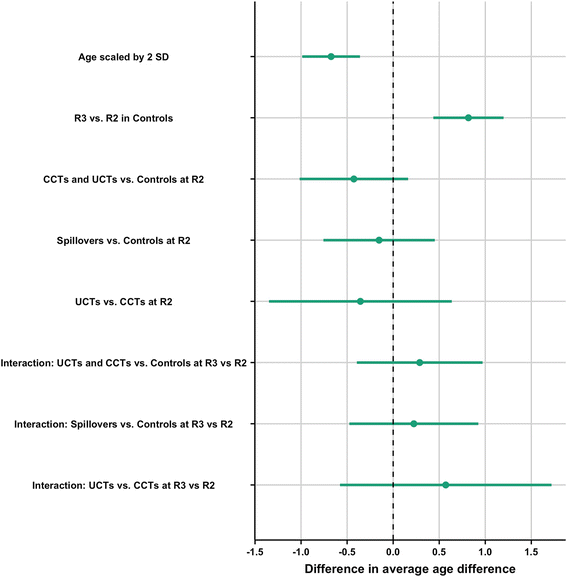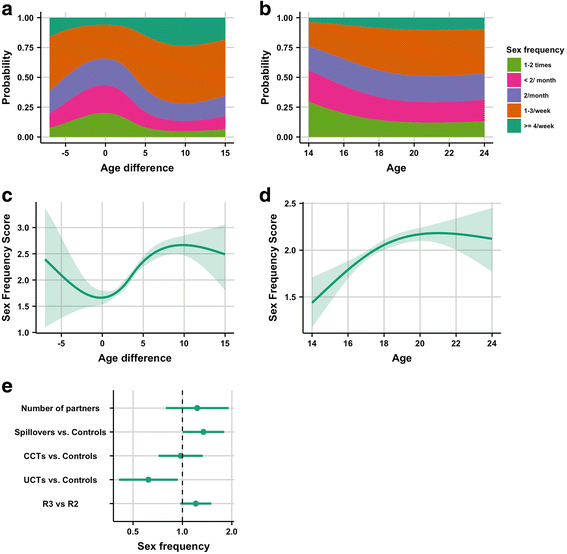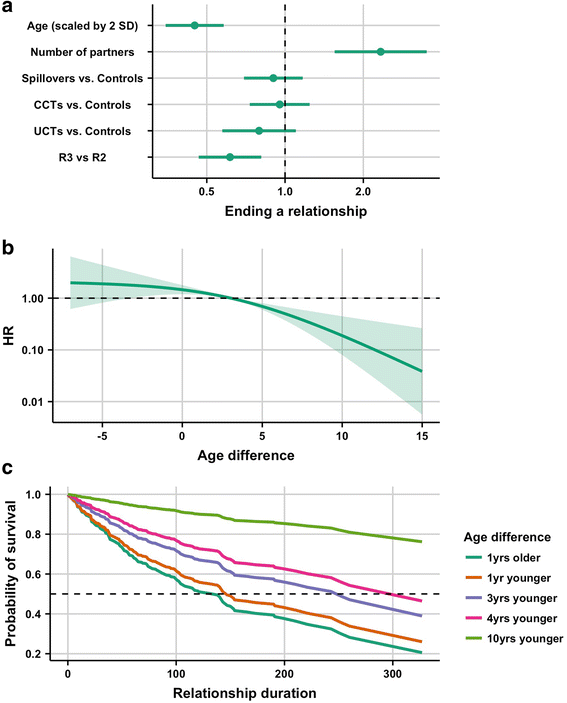Partner age differences and associated sexual risk behaviours among adolescent girls and young women in a cash transfer programme for schooling in Malawi
- PMID: 29587710
- PMCID: PMC5872581
- DOI: 10.1186/s12889-018-5327-7
Partner age differences and associated sexual risk behaviours among adolescent girls and young women in a cash transfer programme for schooling in Malawi
Abstract
Background: Age disparities in sexual relationships have been proposed as a key risk factor for HIV transmission in Sub-Saharan Africa, but evidence remains inconclusive. The SIHR study, a cluster randomised trial of a cash transfer programme in Malawi, found that young women in the intervention groups were less likely to have had a sexual partner aged 25 or older, and less likely to test positive for HIV and HSV-2 at follow-up compared to control groups. We examined the hypotheses that girls in the intervention groups had smaller age differences than control groups and that large age differences were associated with relationship-level HIV transmission risk factors: inconsistent condom use, sex frequency, and relationship duration.
Methods: We conducted an analysis of schoolgirls in the Schooling, Income, and Health Risk (SIHR) study aged 13-22 at baseline (n = 2907). We investigated the effects of study arm, trial stage and participant age on age differences in sexual relationships using a linear mixed-effects model. Cumulative-link mixed-effects models were used to estimate the effect of relationship age difference on condom use and sex frequency, and a Cox proportional hazard model was used to estimate the effect of relationship age difference on relationship duration. We controlled for the girl's age, number of partners, study group and study round.
Results: Girls receiving cash transfers, on average, had smaller age differences in relationships compared to controls, though the estimated difference was not statistically significant (- 0.43 years; 95% CI: -1.03, 0.17). The older the participant was, the smaller her age differences (- 0.67 per 4-year increase in age; 95% CI: -0.99, - 0.35). Among controls, after the cash transfers had ended the average age difference was 0.82 years larger than during the intervention (95% CI: 0.43, 1.21), suggesting a possible indirect effect of the study on behaviour in the community as a whole. Across treatment groups, larger age differences in relationships were associated with lower levels of condom use, more frequent sex, and longer relationship durations.
Conclusions: Cash-transfer programmes may prevent HIV transmission in part by encouraging young women to form age-similar relationships, which are characterised by increased condom use and reduced sex frequency. The benefits of these programmes may extend to those who are not directly receiving the cash.
Keywords: Age-disparate relationships; Age-mixing; Malawi; Sexual risk behaviour; Southern Africa.
Conflict of interest statement
Ethics approval and consent to participate
Institutional Review Board approval to conduct this secondary analysis was obtained from the Stellenbosch University Health Research Ethics Committee (IRB0005239). The requirement for written consent was waived by the ethics committee because this was a secondary analysis, and no participants were contacted, nor did we have access to identifying information.
Consent for publication
Not applicable.
Competing interests
The authors declare that they have no competing interests.
Publisher’s Note
Springer Nature remains neutral with regard to jurisdictional claims in published maps and institutional affiliations.
Figures






Similar articles
-
ASSOCIATION BETWEEN HIV AWARENESS FACTORS, HEALTH FACILITY CHARACTERISTICS AND RISKY SEXUAL BEHAVIOUR AMONG YOUNG WOMEN IN ZOMBA DISTRICT, MALAWI.J Biosoc Sci. 2018 Nov;50(6):853-867. doi: 10.1017/S0021932017000694. Epub 2018 Jan 30. J Biosoc Sci. 2018. PMID: 29380721
-
Child-focused state cash transfers and adolescent risk of HIV infection in South Africa: a propensity-score-matched case-control study.Lancet Glob Health. 2013 Dec;1(6):e362-70. doi: 10.1016/S2214-109X(13)70115-3. Epub 2013 Nov 26. Lancet Glob Health. 2013. PMID: 25104601
-
Age differences between sexual partners, behavioural and demographic correlates, and HIV infection on Likoma Island, Malawi.Sci Rep. 2016 Nov 2;6:36121. doi: 10.1038/srep36121. Sci Rep. 2016. PMID: 27805053 Free PMC article.
-
Cash transfers for HIV prevention: A systematic review.PLoS Med. 2021 Nov 29;18(11):e1003866. doi: 10.1371/journal.pmed.1003866. eCollection 2021 Nov. PLoS Med. 2021. PMID: 34843468 Free PMC article.
-
Evidence on delay in sexual initiation, multiple partnerships and condom use among young people: review of Caribbean HIV behavioural studies.West Indian Med J. 2013;62(4):292-8. doi: 10.7727/wimj.2013.025. West Indian Med J. 2013. PMID: 24756588 Review.
Cited by
-
Coital frequency and condom use in age-disparate partnerships involving women aged 15 to 24: evidence from a cross-sectional study in KwaZulu-Natal, South Africa.BMJ Open. 2019 Mar 9;9(3):e024362. doi: 10.1136/bmjopen-2018-024362. BMJ Open. 2019. PMID: 30852536 Free PMC article.
-
Spousal age differences and women's contraceptive use in sub-Saharan Africa.Contracept Reprod Med. 2024 Sep 26;9(1):45. doi: 10.1186/s40834-024-00306-7. Contracept Reprod Med. 2024. PMID: 39327605 Free PMC article.
-
Age-disparate and intergenerational sex partnerships and HIV: the role of gender norms among adolescent girls and young women in Malawi.BMC Public Health. 2024 Feb 22;24(1):575. doi: 10.1186/s12889-024-17868-5. BMC Public Health. 2024. PMID: 38389081 Free PMC article.
-
Partner age difference and sociodemographic correlates of herpes simplex virus type 2 seropositivity: A community-based study in South India.Indian J Sex Transm Dis AIDS. 2020 Jul-Dec;41(2):219-221. doi: 10.4103/ijstd.IJSTD_90_18. Epub 2020 Jul 31. Indian J Sex Transm Dis AIDS. 2020. PMID: 33817604 Free PMC article. No abstract available.
-
Variations in HIV Risk by Young Women's Age and Partner Age Disparity in Rural South Africa (HPTN 068).J Acquir Immune Defic Syndr. 2020 Apr 1;83(4):350-356. doi: 10.1097/QAI.0000000000002270. J Acquir Immune Defic Syndr. 2020. PMID: 31904708 Free PMC article.
References
-
- Gouws E, Williams BG. Age-mixing and the incidence of HIV among young women. Lancet HIV. 2016;3018(16):10–11. - PubMed
Publication types
MeSH terms
Grants and funding
LinkOut - more resources
Full Text Sources
Other Literature Sources

